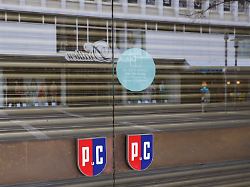Bankruptcies in the fashion industry
“In five years we will experience a start-up boom”
09/01/2023, 03:08 p.m
Difficulties are mounting in the fashion industry, brands and chains such as Peek & Cloppenburg are going through insolvency proceedings. The insolvency administrator Christian Gerloff explains where the problems lie – and why things could soon pick up again.
Gerry Weber insolvent, Hallhuber insolvent, the retailer Peek & Cloppenburg with problems: there have been over 40 insolvencies in the fashion industry since the beginning of the year. What is happening?
Christian Gerloff: We have had a change in the industry for years, which has very different causes. New players are coming, for example with fast fashion, which has also caused problems for established brands. At the same time, we have a lot of older brands, especially in Germany. And some brands will die out if they don’t reinvent themselves in every generation.
And what about the problems in retail?
Shopping behavior is changing very strongly, also due to online business. In addition, we simply have an oversupply of fashion, we had a strong expansion of retail space in the inner cities. Together with the consequences of the corona pandemic and high inflation, this is hitting an industry that is already in a state of upheaval even harder.
Have the companies done too little with their brands?
It is certainly the case that some have not developed their products forward enough. There are those in the women’s sector who say: We make fashion for women over 50. But they’ve been saying that for 20 or 30 years. Without realizing that these customers are now 70 or 80 years old. You don’t even ask yourself if you can still reach the new 50-year-old. There are similar phenomena in the retail sector: there is a failure to make one’s own retail business exciting, to lead it into the new era.
You also spoke of new providers making things more difficult.
Yes, we are experiencing shorter and shorter cycles on the market. More and more labels are hyped for a short time and then have difficulties. The mechanisms have changed significantly in the last ten years.
How can it be explained that not only stationary trade has a problem, but also online trade, which was considered to be the future?
In fact, there are relatively few online stores that are profitable. Most write losses. The reason is clear: they have to touch the goods several times due to returns, they have high marketing costs and there is greater comparability with other providers. The price comparison leads to a completely different pressure than in stationary retail. I recently had an online sports provider whose marketing costs were 35 percent. If the goods come back two or three times, you don’t have to have studied mathematics to know that it can’t work.
Does that mean that such offers are not sustainable in the long run and will disappear?
Everyone should focus on what they can do. Selling online is very different from brick-and-mortar retail. And of course every stationary retailer should have an online presence. But that doesn’t mean that he also runs his own online shop. It’s not easy to connect with each other.
Why is it hitting the fashion industry so hard?
This industry has of course been particularly hard hit by the pandemic and the lockdowns. And the current reluctance to buy is also hitting these providers extremely hard. As a result, we have several cases in which the same company had to file for insolvency twice in a short period of time.
There is often a consolidation in such industries – in which there are simply fewer and larger providers at the end. How’s that in fashion?
Gerry Weber, for example, has closed a large number of stores. There is a clear reduction. Galeria has also become significantly smaller. A market shakeout is already taking place.
And what happens to these areas, do they simply remain empty?
This is indeed a problem. The question is what happens in certain inner-city locations. You can already see the problem in medium-sized cities. Clever concepts are needed here. The resulting gaps will certainly be filled by other providers at some point. I believe that we will experience a kind of start-up boom. But that will take another four or five years.
Nils Kreimeier spoke to Christian Gerloff
